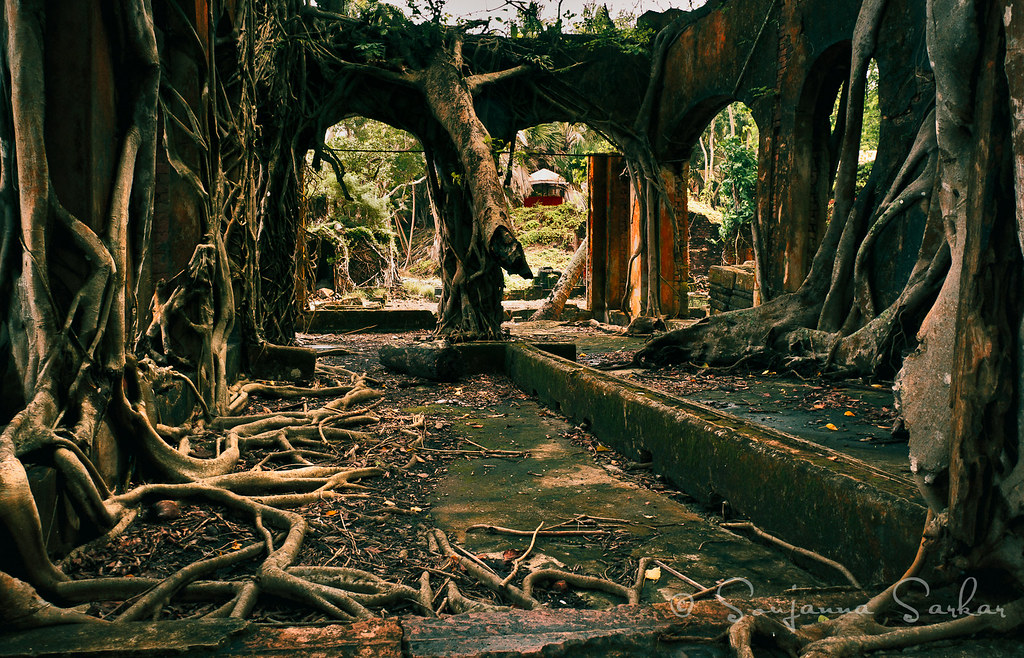Abandoned colonial architecture covered with big tree roots at Ross island. Photo credit: CRS PHOTO/Shutterstock
For more than eighty years, a remote island in the archipelago of Andaman Islands in the Bay of Bengal, served as a penal colony for Indian dissidents and mutineers who tried to revolt the British colonial rule of India. Measuring less than one-third of a square kilometer, the tiny Ross Island became infamous for the brutalities inflicted by the British upon thousands of convicts and political prisoners. Ross Island was the British equivalent to the Soviet gulags and the Nazi death camps. Everything from torture, forced labor and medical experimentation took place here. The death toll was immense.
Located more than 1,100 km away from the Indian peninsula, in the middle of the Indian Ocean, the Andaman Islands were perfectly suited for a penal colony where the Empire’s enemies could be sent to exile. It was in 1856—one year before the Indian mutiny would break the back of the British East India Company, eventually dissolving it and transferring its ruling powers to the British Crown—that plans were first drawn for a convict establishment in the island.
The British wanted to transport the convicts beyond the seas, because according to ancient Hindu scriptures, a journey across the sea was taboo that resulted in the loss of one’s social respectability and, as per Sir Robert Napier, “separation forever from every tie and relation and possession which men hold to in life.” It was this bizarre belief that prevented many Indian traders from engaging in maritime trade—a behavior that Portuguese sailors during the Age of Discovery found puzzling.
Abandoned colonial architecture covered with big tree roots at Ross island. Photo credit: Sun_Shine/Shutterstock
This decree was called kala pani, which literally meant “black water”. Later, the penal colony itself came to be known as kala pani. The British hoped that the word would instill fear among all Hindus across the Empire. An incarceration in this jail, they hoped, would threaten convicts with the loss of caste and the resulting social exclusion. However, before construction could commence the Revolt of 1857 broke out. It was the first of many rebellions that would follow against the British rule. Tens and thousands of freedom fighters were arrested, which made the need for a penal colony even more urgent.
When the British first arrived at Andaman in 1858 with 200 convicts, the islands of the archipelago were covered in impenetrable jungle. Ross Island was chosen as the first convict settlement due to the availability of water. The arduous task of clearing the dense forest fell upon the inmates, while the officers stayed on the ships. Chained and collared around the neck with iron, these prisoners toiled in the intense tropical heat and monsoon rain to build basic shelters for themselves, as well as other buildings and roads.
Abandoned colonial architecture covered with big tree roots at Ross island. Photo credit: CRS PHOTO/Shutterstock
Over the years the number of prisoners in Ross Island grew to over 15,000. Nearly all of them suffered from one sickness or the other. Malaria, pneumonia and dysentery were the leading causes of death. Others succumbed to torture and malnutrition. Those working in the fields became victims to the indigenous people, some of which practiced cannibalism. Medical experimentation also took place at Ross Island. One time British authorities force fed 10,000 prisoners with quinine, then still an experimental drug, to see its effects. Some got diarrhea, others got depressed and began injuring each other. The authorities reacted by hanging those affected.
As the penal colony expanded into neighbouring islands, Ross Island was converted into the administrative headquarters and an exclusive settlement for high-ranking officers and their families. Anyone visiting Ross island would have been surprised by the transformation. Grand mansions replete with period furniture, manicured lawns and tennis courts were constructed, along with bazaar, bakery, stores, hospital, churches, water purification plant and everything else to make life in the island as comfortable as possible. Today, every standing building has been devoured by the encroaching forest. The rest was leveled by a magnitude of 7.7 earthquake that hit the Andaman Islands in 1941.
Old presbyterian church ruins at Ross Island. Photo credit: PI/Shutterstock
After the devastating earthquake, Ross Island was nearly abandoned. Those who remained were driven out by the Japanese army during the Second World War, who too left their imprint on the island in the form of bunkers. Shortly before India’s independence in 1947, the penal colony was disbanded. For thirty years, the island and the ruins of the former colony remained untouched until the property was taken over by the Indian Navy in 1979.
Today the island exist as a tourist attraction a short boat ride away from Port Blair, the capital of Andaman and Nicobar Islands, where the infamous Cellular Jail is located.
Creepers cover the ruins on Ross Island. Photo credit: CRS PHOTO/Shutterstock
The former power house on Ross Island. Photo credit: CRS PHOTO/Shutterstock
Photo credit: Stefan Krasowski/Flickr
Photo credit: Sudhamshu Hebbar/Flickr





















Comments
Post a Comment